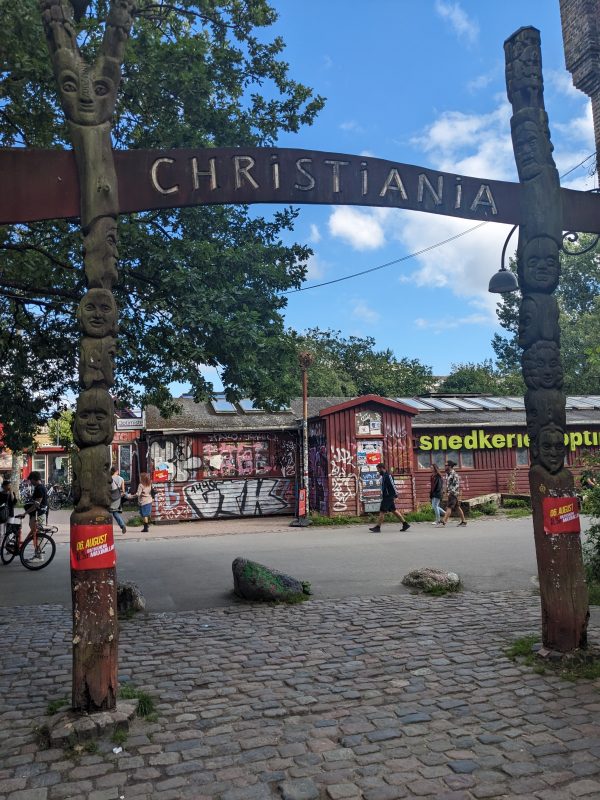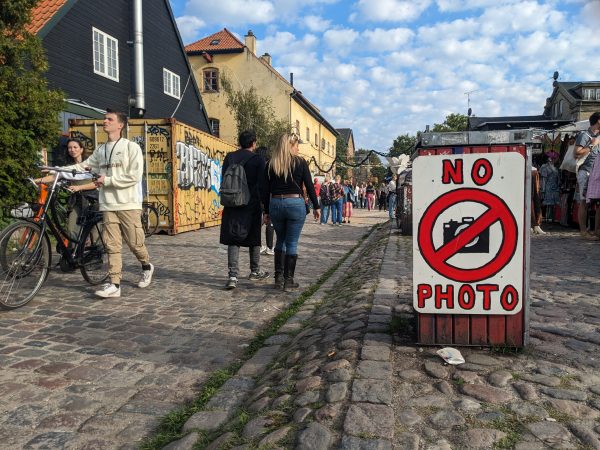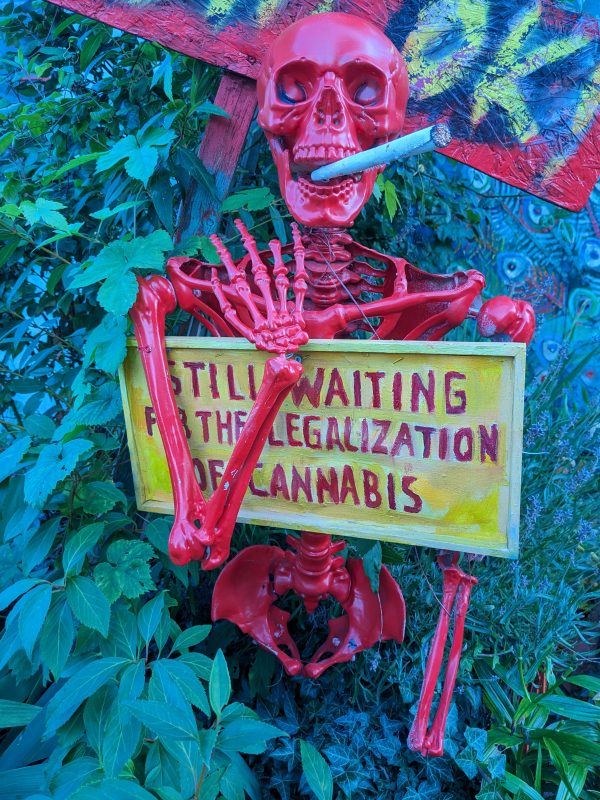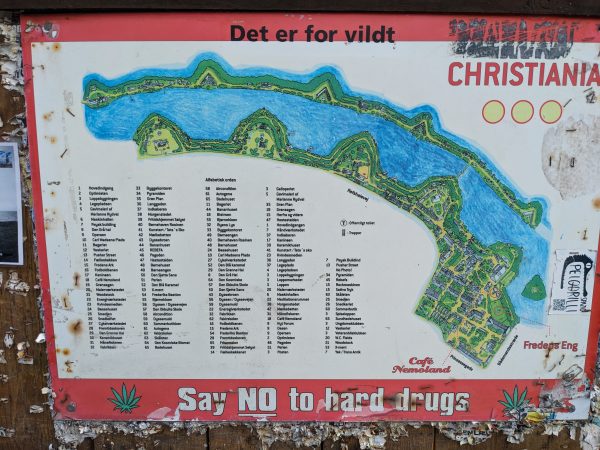In the year 1623, Christian IV, king of Denmark and Norway, built a long series of moats and ramparts just across from central Copenhagen, on the eastern edge of the city’s harbor, to protect the city from Swedish invasion. In the early 19th century, the Danish government added artillery barracks. And in the 20th century, they filled in the surrounding swamps to make room for a modern military base, even as the rest of Copenhagen grew around it. That is until 1971, explains Far From Home reporter Scott Gurian, when the Danish defense ministry closed the base for good, and Copenhagen’s countercultural youth wasted no time breaking into the now vacant fortress and squatting in various buildings.
But contrary to what one might expect, the abandoned base was not a cramped, depressing, concrete jungle. At 85 acres, it contained vast green spaces, hills and patches of forest. There was even a lake, with empty stables and ammunition depots scattered in charming arrangements around the landscape. The squatters couldn’t believe their luck, and as word spread about the empty wilderness inside the fortresses walls, the compound quickly became a haven for the unwanted, abused, and dispossessed.

The squatters quickly declared the base in the middle of the city “a politically autonomous anarchist zone.” Or, in plainer English, a commune. Taking a cue from the surrounding “Christian’s Harbor” neighborhood, they called it “Christiania.”
Like many other communes, Christiania’s founders wanted the new world they made within the walls to be as free as possible from all the old world’s rules and customs and hierarchies. They drew up a mission statement, according to which the goal of the commune was quote “to create a self-governing society whereby each and every individual holds themselves responsible for the well-being of the entire community.”

As Christiania’s population swelled to roughly 1000 people, the residents began adapting the existing structures, building fantastical homes out of recycled objects and filling them with amazing art. They turned a former stable into a church, and transformed a military horse riding arena into a concert hall. There were also small businesses, including a factory that made customized bicycles, and a women’s blacksmith shop – and it was all happening within the walls, completely surrounded by Copenhagen’s old city.
Christiania wasn’t totally cut off from the outside world. Its residents would engage in commerce, and come and go into the rest of the city. But inside the walls, the community collected its own trash and recycling, operated its own kindergarten, and even had its own newspaper and marching band.

Aside from a small shared maintenance fee, residents paid no rent. No one owned their home, and when they moved out, there was nothing to sell. There were no building or zoning codes. There were also no laws. The only rules were: no private ownership of land or housing, no weapons or violence, and no vehicles.
Otherwise, people in Christiania were free to do pretty much whatever they wanted. Play rock music in the streets, do drugs, sell drugs, wear their hair long or shave it off, love members of the same sex or a different race. All the things, in the other words, that were still dangerous or impossible in the world outside its gates.
The individual freedom on offer in Christiania attracted people from around the world, but there were other advantages too – like the consensus system the community used for settling disputes and making collective decisions, which called for everyone present at a meeting to work out their differences and arrive at a unanimous understanding before making any decision.
As for what the Danish authorities thought of the thousand or so people squatting on 85 acres of state property in the middle of the nation’s capital: On several occasions in the decade following its founding, the Copenhagen police tried to remove the squatters, only to be met with determined resistance in forms of barricades. Scared of Christiania turning into another of Europe’s squatter battlegrounds, the Danish government changed course and decided to tolerate the commune.

Meanwhile, outside the gates, the initial perception that this was just a group of lazy, pot-smoking hippies was changing, especially after favorable coverage on Danish television depicted what day-to-day life was actually like in the commune. Hundreds of thousands of tourists began flocking every year to the anarchist parkland in the center of the Danish capital. Its musical venues started hosting concerts featuring everyone from Bob Dylan to Metallica. Christiania slowly became a fact of life and, by the mid 1980s, an iconic part of Copenhagen. Today, it’s one of the longest-lasting and most celebrated communes in the world, and a magnet for people searching for alternative ways of living – existing both side-by-side and within a major European city.
But, starting in the mid 2000s, a cascade of problems forced Christiania’s residents to rethink some of their most cherished freedoms and depend more and more on help from the rest of Danish society. And many worried the changes were making their counter-cultural haven more like the rest of Denmark in the process.
The drug market in Christiania was known as Pusher Street, and it’s considered by many to be where the commune’s problems began. Drug sales on Pusher Street was restricted to cannabis only (starting in the late seventies), and in its best years it was seen as a kind of friendly farmers market for weed and hash. But it was also the only place in Copenhagen where the government turned a blind eye to drug use, which made it an attractive market for international criminal gangs, who sold the local dealers cannabis imported from Afghanistan and Morocco. As a result, various gangs had an on-and-off presence on Pusher Street starting in the 1980s.

Then, around 2004, a new conservative government came into power and increased the penalties for cannabis dealing. The Copenhagen Police also violated the commune’s (still unofficial) sovereignty by conducting occasional raids on Pusher Street and making arrests – not actually a new practice, but one that now carried much more dire consequences for dealers. The effect was to scare most of the local dealers away from Pusher Street. It also drove prices up, and the gangs swept in to fill the lucrative vacuum. The gangs then began fighting each other for control over Pusher Street, turning it, in the past decade, into a notorious hot spot for gang violence – including beatings, stabbings, masked gunmen opening fire in public, and a string of shooting deaths.

Many Christiania residents have always believed that the best way to fix the problem would be to legalize cannabis in Denmark. Legalization would take power away from the gangs. But so far, that’s something Denmark’s federal government has been unwilling to do. So the residents recently decided they had no choice but to change one of the fundamental things that made Christiania different in the first place. In the absence of legalization – and having lost all control of Pusher Street – they decided to ban drug sales in the community.
Of course, faced with a ban, the dealers working for the gangs would have just refused to leave, knowing the unarmed residents would be powerless to enforce the new law. Which is why the residents also decided to reverse another long-standing tradition. They issued a public statement saying that they were unable to close Pusher Street on their own – effectively inviting the police to come in and enforce the closure for them – which they did in April of 2024. The irony of which was not lost on anyone: To kick the gangs out, the anarchists of Christiania had to ask the state for help.
But some Christiania residents who had been opposed to the decision claimed that the consensus system was actually hijacked by an aggressive minority of people who wanted Pusher Street closed, and that the outcome didn’t reflect the real will of the community. Meanwhile, those who had advocated for the drug ban insisted they were in the firm majority. Either way, it was clear the consensus system hadn’t fully created consensus, and that it, too, might be buckling under the various stresses being placed on the commune.
And recently, Christiania’s residents struck another deal with the government that could integrate the commune with the city even more. Denmark is struggling with an affordable housing crisis, and Christiania’s undeveloped green spaces – so close to the center of the city – could be part of a solution. But the situation has rekindled the residents’ fears of being evicted from their homes, which they still do not technically own. So a few years ago, Christiania and the Danish government struck a bargain. The state will allow the community to own its land outright by purchasing it for far below market value. But, in return, Christiania will have to build government-subsidized, low income apartments for 300 new people.

The new deal has spurred a fresh round of debate among residents. Some think the volume of the new buildings will ruin the landscape that made Christiania iconic in the first place. They also point out that the commune has long had a policy of deciding who gets housing inside the walls – thereby ensuring that the community remains a haven for cultural outsiders. They worry the 300 new residents – who will likely be chosen using more traditional economic needs-based metrics – will not fit in with the existing culture, and eventually turn Christiania into just another typical Copenhagen neighborhood.
But other residents want to use the low-income housing as an opportunity to reinvigorate Christiania’s commitment to the downtrodden and adrift. They believe there are ways to work with the government to both create new buildings that respect the commune’s green space and make sure the new residents will help it carry on being a hub for Denmark’s counter-culture.
They worry that if Christiania isn’t willing to work with the outside world, it will slowly die – or worse, become a kind of hippie museum, with its once radical institutions calcified into outdated traditions. They believe that just like with any community – radical or not – the only real constant is change.



Leave a Comment
Share